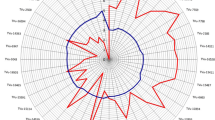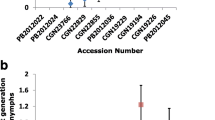Abstract
Aphis gossypii Glover (Hemiptera: Aphididae) is among major arthropods causing significant damage to okra in the tropics. Resistant varieties could reduce aphid infestation and increase productivity. This study was carried out to identify aphid-resistant and high yielding okra accessions for management of the pest. Eleven farmers’ varieties and four aphid-resistant accessions from AVRDC were evaluated at its Nkolbisson station in Yaounde, Cameroon. Field screening was done to determine resistance to aphids, days to 50% anthesis and days to 50% commercial maturity. Aphid data was expressed as the area under infestation pressure curve and subjected to statistical analysis based on mean (m) and standard deviation (S.D.). Crop cycle and yield data were subjected to analysis of variance. Accession ‘VI033824’ was the most resistant to aphids (474 ± 41.9 per leaf) with yield 0.76 ± 0.26 t/ ha whereas the yield of the highly susceptible Babungo (1519.8 ± 0.0 aphids) was 1.33 ± 0.07 t/ha, 75.5% higher that the yield of the only resistant variety. Abelmoschus esculatus was less attacked (601.4 ± 60.0 aphids) by aphids than Abelmoschus caillei (826.0 ± 71.6 aphids; df = 1, 41; Pr {>Chi} = 0.037). The yield of A. caillei species were higher (1.26 ± 0.14 t/ha) than A. esculentus species (0.43 ± 0.08 t/ha; df = 1, 41; Pr {>Chi} = 0.0002). Hence, varieties with resistance, tolerance to aphids and earliness could be incorporated into integrated pest management of aphids and enhance productivity of okra.




Similar content being viewed by others
References
Abang AF (2018) Interactions between the germplasm of okra (Abelmoschus spp.) and aphids with special reference to Aphis gossypii glover (Hemiptera: Aphididae) in Cameroon. Thesis presented in partial fulfilment of the requirements for the award of PhD in biology of animal organism, University of Yaoundé 1, Cameroon
Abang AF, Kouame CM, Abang M, Hanna R, Fotso AK (2013) Vegetable growers’ perception of pesticide use practices, cost, and health effects in the tropical region of Cameroon. Int J Agron Plant Prod 4:873–883
Abang AF, Kouamé CM, Abang M, Hanna R, Fotso AK (2014) Assessing vegetable farmer knowledge of diseases and insect pests of vegetable and management practices under tropical conditions. Int J Veg Sci 20:240–253. https://doi.org/10.1080/19315260.2013.800625
Ajayi OC (2005) Biological capital, user costs and the productivity of insecticides in cotton farming systems in sub-Saharan Africa. Int J Agric Sustain 3:154–166
Anitha KRS, Nandihalli B (2009) Evaluation of some okra hybrids against leaf hopper and aphid. Karnataka J Agric Sci 22:718–719
Asawalam EF, Emeasor KC, Adieze O (2007) Influence of some soil amendments on insect pest infestation and damage to okra Abelmoschus esculentus (L.) Moench in Umudike, Abia State. Res J Biol Sci 2:108–111
Avallone S, Tiemtore TWE, Rivier CM, Treche S (2008) Nutritional value of six multi ingredient sauces from Burkina Faso. J Food Compos Anal 21:553–558
AVRDC (Asian Vegetable Research and Development Center) (1979) Progress report for 1978. Shanhua, Taiwan, Republic of China
Belmain SR, Haggar J, Holt J, Stevenson PC (2013) Managing legume pests in sub-Saharan Africa. In: challenges and prospects for improving food security and nutrition through agroecological intensification. Natural Resources Institute, University of Greenwich, p 34
Chabi-Olaye A, Nolte C, Schulthess F, Borgemeister C (2005) Effects of grain legumes and cover crops on maize yield and plant damage by Busseola fusca (fuller) (Lepidoptera: Noctuidae) in the humid forest of southern Cameroon. Agric Ecosyst Environ 108:17–28
Deguine JP, Hau B (2001) The influence of the plant on Aphis gossypii. Some results of research conducted in Cameroon. In: Gourlot, J-P and Frydrych, R. (eds), Improvement of the marketability of cotton produced in zones affected by stickiness: project CFC/ICAC/11. CFC, CIRAD-CA-COTON, IFTH, SCC, ARC. Amsterdam: CFC, 1 cd-rom CIRAD-CA, cotton program, TA 72/09, 34398 Montpellier Cedex 5, France. Pp. 86-98
Djiéto-Lordon C, Aléné DC, Reboul JL (2007) Contribution à la connaissance des insectes associés aux cultures maraîchères dans les environs de Yaoundé – Cameroun. Cameroon J Biol Biochem Sci 15:1–13
Dogimont C, Bendahmane A, Chovelon V, Boissot N (2010) Host plant resistance to aphids in cultivated crops: genetic and molecular bases, and interactions with aphid populations. C R Biol 333:566–573
Ellis-Jones J, Stenhouse J, Gridley H, Hella J, Onim M (2008) Vegetable breeding and seed Systems for Poverty Reduction in Africa. Baseline Study on Vegetable Production and Marketing. Cameroon vBSS Baseline Synthesis Report - final draft
FAO (2015) Food and agricultural Organization of the United Nations. FAO’s corporate database. http://faostat3.fao.org/browse/Q/QC/E (last accessed 11 Mar 2016)
Horber E (1980) Types and classification of resistance. In: Maxwell FG, Jennings PR (eds) Breeding plants resistant to insects. John Wiley and Sons, New York, pp 15–21
Hughes J (2009) Just famine foods? What contribution can underutilized plants make to food security? Acta Hortic 806(1):39–47
Ijoyah MO (2010) Productivity of okra (Abelmoschus esculentusL. Moench) at varying sowing dates in Makurdi, Nigeria. J Appl Biosci 32:2015–2019
Kekeunou S, Messi J, Weise S, Tindo M (2006) Insect pests’ incidence and variations due to forest landscape degradation in the humid forest zone of southern Cameroon: farmers’ perception and need for adopting an integrated pest management strategy. Afr J Biotechnol 5:555–562
Kendall CWC, Jenkins DJA (2004) A dietary portfolio: maximal reduction of low-density lipoprotein cholesterol with diet. Curr Atheroscler Rep 6:492–498
Kessler A, Baldwin IT (2001) Defensive function of herbivore-induced plant volatile emissions in nature. Science 291:2141–2144
Koch KG, Chapman K, Louis J, Heng-Moss T, Sarath G (2016) Plant tolerance: a unique approach to control hemipteran pests. Front Plant Sci 7:1–12
Kogan M, Ortman EE (1978) Antixenosis-a new term proposed to replace Painter’s “non-preference” modality of resistance. Bull Entomol Soc Am 24:175–176
Kogan M, Paxton J (1983) Natural inducers of plant resistance to insects. In: Hedin P.A. (ed.), Plant Resistance to Insects. Am. Chem. Soc. Symp. Series 208. Washington, DC: American Chemical Society, pp. 153–171
Koornneef M, Bentsink L, Hilhorst H (2002) Seed dormancy and germination. Curr Opin Plant Biol 5:3336
Kumar S, Dagnoko S, Haougui A, Ratnadass A, Pasternak D, Kouame C (2010) Okra (Abelmoschus spp.) in west and Central Africa: potential and progress on its improvement. Afr J Agric Res 5:3590–3598
Leite GL, Picanco DM, Zanuncio JC, Gusmao MR (2007) Factors affecting colonization and abundance of Aphis gossypii glover (Hemiptera: Aphididae) on okra plantations. Ciência e Agrotecnologia, Lavras 31: 337–343
Manach C, Williamson G, Morand C, Scalbert A, Remesy C (2005) Bioavailability and bioefficacy of polyphenols in humans. I. Review of 97 bioavailability studies. Am J Clin Nutr 81(1):230–242
Matthews GA, Tunstall JP (1994) Insect pests of cotton. CAB International, Wallingford xii + 593 pp
Metcalf RL, Luckman WH (1994) Introduction to insect pest management, 3rd edn. John Wiley Sons, Inc., New York, 137 pp
Mmolawa OB (1987) Germination and dormancy of meadow foam seed. M.Sc. thesis, Oregon State University, USA
Mohamed-Ahmed MM (2000) Studies on the control of insect pests in vegetables (okra, tomato, and onion) in Sudan with special reference to neem preparations. PhD dissertation, University of Giessen, Germany. 123 pp.
Moyin-Jesu EL (2007) Use of plant residues or improving soil fertility pod nutrients root growth and pod weigth of okra Abelmoschus esculentum L. Bioresour Technol 98:2057–2064
NAP (2006) Lost Crops of Africa Volume II: Vegetables pp 287–301. https://www.nap.edu/catalog/11763.html
Ndemah R (1999) Towards developing a sustainable pest management strategy for the African stalk borer, Busseola fusca (fuller) (Lepidoptera: Noctuidae) in maize systems of Cameroon. Ph. D. Thesis, Hanover University. 320 pp.
Ndemah R, Schulthess F, Korie S, Borgemeister C, Poehling M, Cardwell K (2003) Factors affecting infestation of the stalk borer Busseola fusca (Lepidoptera: Noctuidae ) on maize in the forest zone of Cameroon with special reference to Scelionid egg parasitoids. Environ Entomol 32:51–60
Nderitu JH, Kasina JM, Kimenju JW, Malenge F (2008) Evaluation of synthetic and neem-based insecticide for managing aphids on okra (Malvaceae) in eastern Kenya. J Entomol 5:207–212
Nibouche S, Brevault T, Klassou C, Dessauw D, Hau B (2008) Assessment of the resistance of cotton germplasm (Gossypium spp.) to aphids (Homoptera: Aphididae) and leafhooper (Homoptera: Cicadellidae): methodology and genetic variability. Plant Breed 127:376–382
Ojo J (2016) Pesticides use and health in Nigeria. IFE J Sci 18(4):981–991
Painter RH (1951) Insect resistance in crop plants. The Macmillan Co., New York, pp 24–25
Pearce G, Styrdom D, Johnson S, Ryan CA (1991) A polypeptide from tomato leaves induces wound-inducible proteinase inhibitor proteins. Science 253:895–898
Purquerio V, Luis F, Antonio A, Francisco A (2010) Germination and hardseedness of sedes in okra elite lines. Hortic Bras 28:232–235
Rosenthal JP, Kotanen PM (1994) Rosenthal J, Kotanen P. terrestrial plant tolerance to herbivory. Trends Ecol Evol 9:145–148
Sarria E, Palomares-Rius FJ, López-Sesé AI, Heredia A, Gómez-Guillamón ML (2010) Role of leaf glandular trichomes of melon plants in deterrence of Aphis gossypii glover. Plant Biol 12:503–511
Schippers RR (2000) African indigenous vegetables. An overview of the cultural species. Natural Resources Institute/ACP-EU Technical Centre for Agricultural and Rural Cooperation, Chatham 214pp
Scriber JM, Feeny P (1979) Growth of herbivorous caterpillars in relation to feeding specialisation and to the growth form of their host plants. Ecology 60:829–850
Shaner G, Finney RE (1977) The effect of nitrogen fertilization on the expression of slow-mildewing resistance in Knox wheat. Phytopathology 67:1051–1056
Shannag HK, Al-Qudah JM, Makhadmehi M, Freihat NM (2007) Differences in growth and yield responses to Aphis gossypii glover between different okra varieties. Plant Prot Sci 43:109–116
Shereen ME (2007) Insect interactions of three trophic levels on milkweed plant, Asclepias sinaica (Boiss) Musch. Int J Agric Biol 9:292–293
Siemonsma JS (1982) West-African okra - morphological and cytogenetical indications for the existence of a natural amphidiploid of Abelmoschus esculentus (L.) Moench and A. manihot (L.) Medikus. Euphytica 31:241–252
Siemonsma JS, Kouamé C (2004) Abelmoschus esculentus (L.) Moench. Internet record from Protabase. Grubben GJH, Denton OA (eds.), PROTA (plant resources of tropical Africa, Wageningen, Netherlands. http://database.prota.org/search.htm
Smith CM (1989) Plant resistance to insects: A fundamental approach. Wiley Sons, Inc., New York, 294 pp
Smith CM (2005) Plant resistance to arthropods. Springer, Dordrecht
Strauss SY, Agrawal AA (1999) Strauss S, Agrawal A. the ecology and evolution of plant tolerance to herbivory. Trends Ecol Evol 14:179–185
Sumathi E (2005) Screening of okra germplasms for their relative resistance to aphid and leafhopper damage. J Ecobiol 17:451–454
Tabacian H, Ravan S, Bandani AR (2011) Susceptibilities of two populations of Aphis gossypii glover to selected insecticides. Afr J Biotechnol 10:670–674
Wanja EW, Hallett RH, Sears MK, Sithanantham S (2001) Insect pest constraints of okra, Abelmoschus esculentus(L.) Moench (Malvaceae), in Kenya. In: ESA 2001 Annual meeting – 2001: an entomological odyssey of ESA, San Diego
Wratten SD, Gurr GM, Tylianakis JM, Robinson KA (2007) Cultural Control. In: van Emden HF, Harrington R (eds) Aphids as crop pests. CAB International, Reading, pp 423–445
Zarpas KD, Margaritopoulos JT, Stathi L, Tsitsipis JA (2006) Performance of cotton aphid Aphis gossypii (Hemiptera: Aphididae) lineages on cotton varieties. Int J Pest Manag 52:225–232
Acknowledgements
We thank the Federal Ministry for Economic Cooperation and Development, Germany for financing this study and the collaboration of the University of Yaoundé I, Cameroon.
Funding
International Institute of Tropical Agriculture (IITA) [grant number 81132671] from Federal Ministry for Economic Cooperation and Development, Germany.
Author information
Authors and Affiliations
Corresponding author
Ethics declarations
Conflict of interest
No potential conflict of interest was reported by the authors.
Additional information
Publisher’s note
Springer Nature remains neutral with regard to jurisdictional claims in published maps and institutional affiliations.
Rights and permissions
About this article
Cite this article
Abang, A.F., Srinivasan, R., Hanna, R. et al. Productivity and resistance of okra (Abelmoschus spp.) to the cotton aphid Aphis gossypii glover (Hemiptera: Aphididae) under tropical conditions. Int J Trop Insect Sci 41, 197–208 (2021). https://doi.org/10.1007/s42690-020-00193-w
Received:
Accepted:
Published:
Issue Date:
DOI: https://doi.org/10.1007/s42690-020-00193-w




